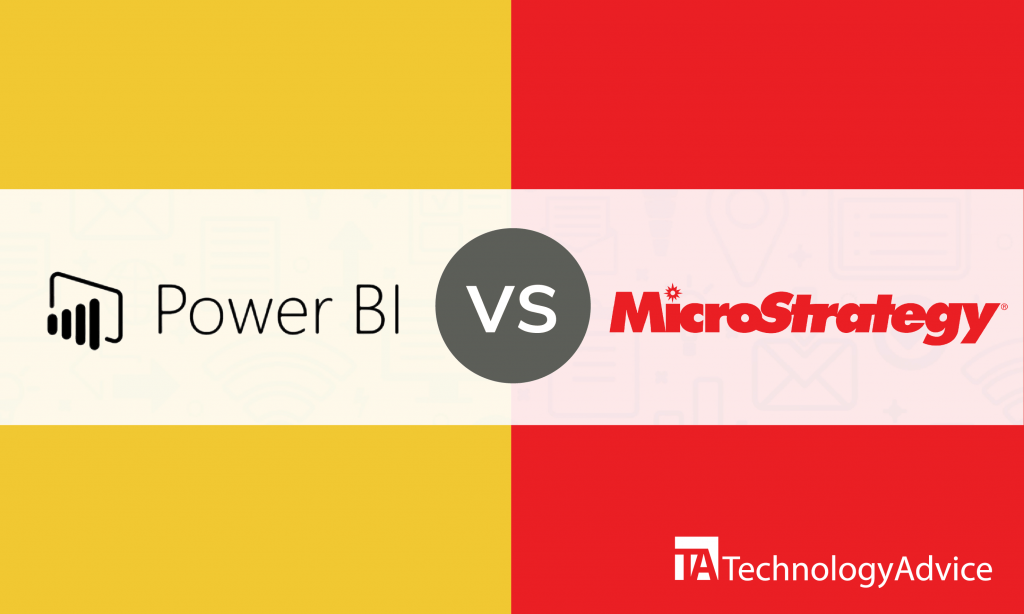- categoryBusiness Intelligence
- ContentComparison
Today’s digital economy is data-driven — and data analytics is the lifeblood. Businesses must evolve and adapt with it or cease to be relevant, as every aspect of a business involves data. Harnessing the power of data keeps your company competitive.
When business decisions are powered by insights based on facts, and not on instinct, they’re transformational and have more impact on the community. This is why the business intelligence industry was born. Two of the competing players, Power BI and MicroStrategy, offer data analytics solutions to businesses so they can unleash the potential of data to transform their business processes, products, and services.
With its initial release in 2014, Microsoft’s Power BI emerged as an industry leader. It provides its clientele with easy-to-use data visualization and business analytics tools that allow them to manage and share data across the organization.
Founded in 1989, MicroStrategy is one of the pioneers, and a formidable competitor, in the business intelligence industry. Building on its analytics engine and mobility platforms, the software offers enterprise-level digital data analytics solutions for both internal and external data to gain insights for better business decisions.
If you already know which features your company needs in your next business intelligence software, TechnologyAdvice can give you fast, free recommendations of the best software for your needs. Use our Product Selection Tool to get started.
User interface and ease of access
Power BI offers a stunning user interface — easy to use and intuitive. If you’ve been using other Microsoft products such as Microsoft Power Platform or Dynamics 365, you will easily feel at home. Familiarity with Excel would be a huge advantage. Having a working knowledge of data analysis expressions (DAX) is particularly helpful in building reports quickly. The drag-and-drop modules make building reports impressively interactive and engaging. You can navigate the panel and access the tools and built-in templates with ease, so you can create visualizations and share the insights immediately to others.
MicroStrategy also has an intuitive dashboard and tools within the panel. It’s easy to navigate, and the interface is simple. You can access the tools to build and deploy applications across all platforms on any device, smoothly and seamlessly.
Its use of “dossier,” which sounds fancier than “folder,” brings analytics to people whether they’re technical or non-technical. The interface is customized and streamlined for easy navigation within the system. So, it’s easy to sift through the data and reports, share information and insights, and work together with their peers.
Data analysis and visualization
Power BI’s modeling tools will save you time and cost of data preparation as they allow you to quickly extract, integrate, analyze, and visualize data. The tools help you simplify complex data sets so you can glean insights for your business decisions. You can connect to data sources, look for trends and patterns, forecast, create visuals, and generate reports. And if you’re an advanced Excel user, you will have the advantage of working in a familiar system.
Users can customize data and create interactive visuals with pre-built tools, templates, and formats.
With MicroStrategy, you can prepare your data sets and put them all together in one powerful enterprise platform. Analyze and share the results of your analysis to your peers across your organization so everyone can access data.
MicroStrategy integrates built-in visualization tools, customized templates, and third-party charts, so it will be easy for the users to explore, visualize, and analyze data.
Read also: Sisense vs. Tableau: A Scalable Business Intelligence Comparison
Users are empowered with Microstrategy. They can build stunning data dossiers by dragging and dropping pre-built and third-party visualization templates, graphs, grids, maps, and charts. They can connect to data from any source — spreadsheets, Salesforce reports, or Hadoop — and modify and transform data with its data wrangling and parsing tools.
Collaboration and integration
Power BI’s easy access to dashboards and tools makes it easy to collaborate with other team members. Other Microsoft technologies such as Azure, Excel, Dynamics 365, and SharePoint integrate with Power BI. Users can access their data on mobile devices, so team members can access data, create visuals, make reports, and publish, even if they’re on the go.
Just like Power BI, MicroStrategy makes collaboration fast and easy as people can use their mobile devices to access data, thus accelerating workflow. As long as every member of the team is connected, they can work wherever they are, and connectivity is secured and fast. Microstrategy brings data to the people. They can work together in the same digital workspace, interact with each other, give feedback and comments, and send and receive notifications within the interface of dossiers.
Scalability and personalization
Although you can also scale up with Power BI, when it comes to scalability at an enterprise level, MicroStrategy has an advantage. You can scale up the tools to deliver data analytics quickly to all people in all departments of your organization. Another advantage of MicroStrategy is personalization of visual analytics, reports, and insights.
Takeaways: Power BI vs. MicroStrategy
These two software solutions offer almost similar features. If you’re a Power BI user, you’ll be pretty much at home with MicroStrategy since both use similar analytics tools and share a common semantic layer. With MicroStrategy, you can deploy data on-premise, in the cloud, or with the hybrid of both. You can manage applications with its self-service admin console, and launch applications on Microsoft Azure.
But Power BI remains the industry leader and is ahead of the pack, especially in the user interface. But MicroStrategy is not far behind, and in fact, it has more in store to offer.
They’re not the only business intelligence solutions to choose from. There are others that you may also consider such as SAP Lumira, Tibco Spotfire, or Tableau. Let us help you find the best BI software for your company’s requirements. Use our Product Selection Tool to get a fast list of recommendations based on your unique needs.
